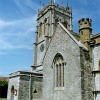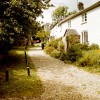This little place is assured a continuing stream of visitors, thanks to a story published in 1898: the thrilling adventure story Moonfleet written by J Meade Faulkner, is set here. The author makes no attempt to disguise the setting under a cloak of fictional anonymity and even goes so far as to weave the real life lords of the manor – the Mohun family – into his tale of smuggling during the mid – 18th century. In 1955 the story was made into a film starring Stewart Grainger.
Nowadays, Fleet is a quiet hamlet but it was once a thriving village community that made their living from agriculture and fishing subsidised by smuggling and the salvaging of cargoes of ships dashed to pieces on the Chesil, a business the villagers were well positioned to exploit.
That was all in the good old days before the dreadful storm of 1824 that wreaked havoc throughout the area, notably washing away Weymouth’s promenade. The people hereabouts relied on the Chesil beach to provide a natural defence from the treacherous seas that run off this part of the coast. The storm that blew in on the night of the 24th of November 1824 cut the Chesil down to size as it carried a tempestuous sea crashing over it, flooding nearby Abbotsbury to a depth of twenty feet. The inhabitants of Butter Street in Fleet watched as their homes were completely destroyed and the church all but washed away; only the chancel was left standing. The Countess of Ilchester came to the aid of villagers sending food and clothing.
Butter Street was rebuilt, but a century later disaster was to call again. In the 1930’s fire took all but one of the homes and again they were rebuilt. In 1826 work got underway on the building of a new church located further inland. The first stone was laid on the 25th of April 1827 and two years later on the 25th of August 1829, the Revd. Robert Gray, the Bishop of Bristol, consecrated the church which is dedicated to the Holy Trinity. The new church comprises a chancel, nave and west tower and is in the style of the 18th century Gothic Revival. A wall plaque in the tower records the destruction of the earlier church.
The name Fleet comes from the lagoon-like stretch of water beside which the hamlet stands. It has been suggested that the name may be a reference to West Bay, as the Saxon name for a bay or gulf was flot, fleot or fleet.
In medieval times the village was the property of Edward the Confessor, who gave it to Earl Harold. The Crown held Fleet at the time of Domesday but it was later granted to The Priory of Christchurch at Twynham, probably when the Priory was established in 1150. After the dissolution of the monasteries it was given for a period of twenty one years to William Cocke, Valet of the Pantry. During the reign of Elizabeth 1st the manor passed to Robert Freke and John Walker and then to Robert Mohun.
Coker’s Survey of Dorset, written early in the 17th century, mentions a large mansion here known as Fleet House, the property of Maximilian Mohun. It was the seat of the Mohun family whose arms can be seen to this day on the two columns at the entrance to the village. The Mohun’s came to England with William the Conqueror. The house has survived a succession of alterations eventually being converted into a hotel. It is located a short distance from the hamlet in a spot facing the calm waters of the Fleet lagoon, sheltered from the north by the rising downs. It is a holiday sun-trap and, not surprisingly, it is named the Moonfleet Manor Hotel.
The chancel of the old church is still standing. Inside on the north wall is a brass plaque commemorating the lives of Robert and Margaret Mohun. They are depicted kneeling at a desk; behind Robert are nine sons and behind Margaret eight daughters. Another plaque has been placed in the old church in memory and recognition of J Meade Faulkner.
Near to the old church a tunnel was discovered, which, it is believed, was used to move contraband secretly and away from the prying eyes of the Revenue men.
John Hutchin gives this pedigree of the Mohun family. The Mohuns of Fleet were descended from Robert Mohun, his brothers being the ancestors of branches of the family in Somerset, Devon and Cornwall. They were: Robert’s son Maximilian (1564-1612) who married Anne daughter of John Churchill of Corton, in 1593; their son Maximilian (1596-1673) married to Elizabeth the daughter of Francis Chaldecot of Whiteway; their son Francis Mohun (1625-1711) married to Eleanor Sheldon; their son Gilbert Maximilian Mohun (1675-1721) who married firstly Elizabeth Squibb who died in 1701, and secondly Sarah daughter of Thomas Cooper of Sherborne. They had several sons, the last surviving, Robert, died without issue in 1758.
In the mid 18th century the estate consisted of manor of East and West Fleet with farms, the glebe of the parsonage, the advowson of the church, and the water known as The Beach – presumably the lagoon.
The manor passed to Robert’s sister, Sarah, and her second marriage was to John Gould of Upwey. Sarah died in 1774 and her husband left the estate to his eldest son by his first marriage to Mary the daughter of the Revd. William Glisson, rector of Marnhull, George Gould of Upwey and Fleet.
George married twice. His second wife was Abigail the daughter of Robert Gooden of Over Compton and the couple had two sons, John and George and the manor passed to them in succession. It was the latter George Gould who became rector of the parish of Fleet. He provided the money and was responsible for building the new church after the storm of 1824; he died in 1841 without marrying.
The estate passed to Miss Catherine Jackson who died in 1847 when it was passed to George Gooden, he later became vicar of Fleet. George was the son of Robert Gooden, the brother of Revd. George Gould’s mother.
This place can feel very sinister. Could it be the ghosts of smugglers past, both real and imagined are just a step away still playing hide and seek with the Revenue Men?



